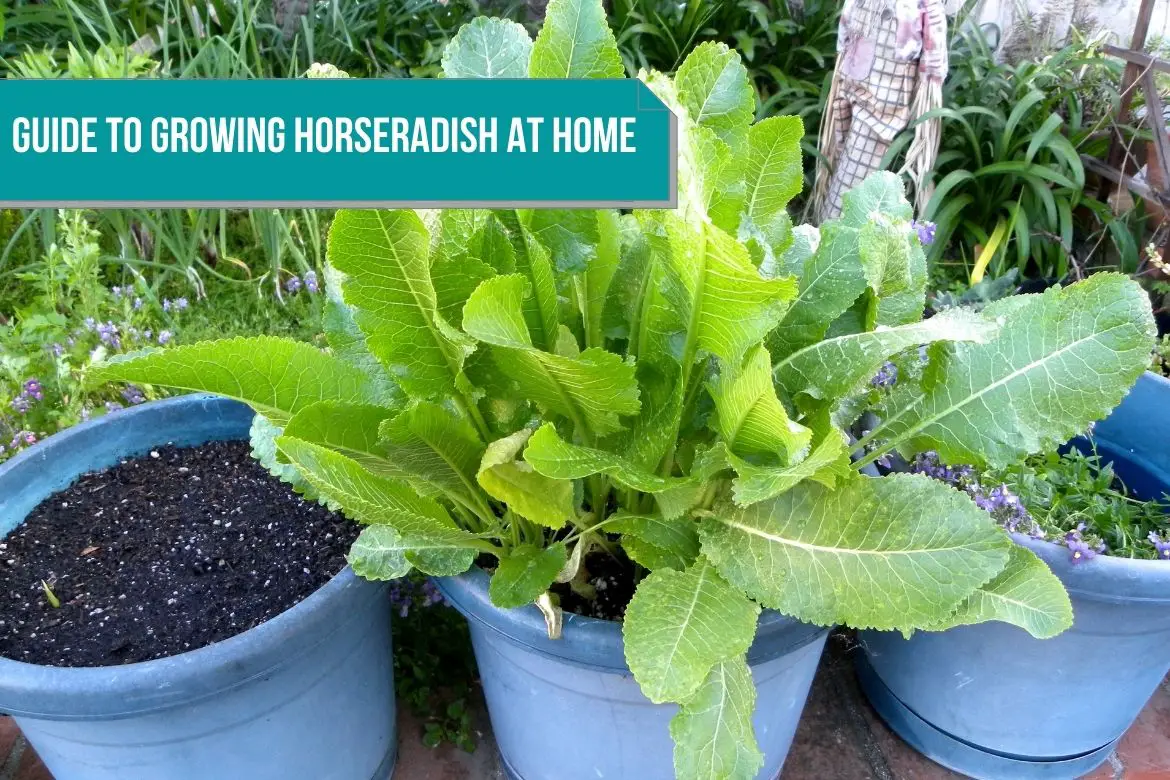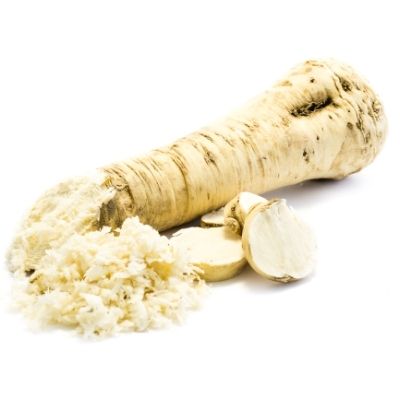
Botanical name : Armoracia rusticana
Flavor Profile : Spicy and pungent. Mustard like.
Horseradish is a flavorful and pungent herb that has been used for centuries to enhance food flavor.
Horseradish is grown for its white, thick, pungent roots, which are generally grated and used as a condiment (cooking horseradish makes it lose its spicy punch). Its tender leaves are also used in salad mixes.
Horseradish is a perennial, hardy herb with large, entire margined leaves that form a rosette of long, flowering stalks that bear small white flowers in a terminal panicle.
Horseradish belongs to the Brassicaceae family, and is related to cabbage, mustard, and other cruciferous vegetables.
Horseradish originated in the southern part of Russia and the eastern part of the Ukraine. However, now it is being cultivated in Europe, central and North America, Asia, and South Africa.
Other than in cultivation, it is often found in fields, home gardens, weedy areas, farmlands, roadsides, ditches, along riverbanks, and disturbed areas in eastern and northern Europe and cold-temperate regions of North America.
FUN FACT : Horseradish was named Herb of the Year for 2011 by the International Herb Association.
Health benefits of Horseradish
Horseradish is antibacterial, antiviral and antifungal in nature.
Its high sulfur content helps to clear sinus passages and eliminate mucus.
It is a natural metabolism booster.
Horseradish aids in digestion and also promotes urination.
Horseradish is used for treating everything from back aches to the common cold.
Horseradish is high in calcium, dietary fibre, folate, manganese, magnesium, potassium, vitamin C and zinc.
Please refer nutrition facts of horseradish for more details
How to grow Horseradish indoors
Horseradish is generally grown in cold-temperate regions.
Horseradish will grow practically anywhere, but its roots are larger, tastier, and less branched if grown properly.
In addition to its low maintenance perennial habit and attractive foliage, it has tremendous value even as a landscape plant.
It is planted as root cuttings or crown in early spring and harvest in the fall season.
Horseradish variety recommendations to grow
- Maliner Kren – It is a sturdy German variety with large roots and vigorous growth.
- New Bohemian – Despite its lower root quality and yield, it is resistant to white rust and mosaic.
- Variegata – It is less invasive, has cream variegated leaves, and tolerates partial shade.
- Big Top Western – The leaves are smooth, large and upright, and the roots are large and of good quality. They are, however, rough or corky on the surface.

Most garden centers do not sell horseradish roots, so use the internet to find them or get a cutting from a gardener or a friend who grows the plants.
In case you are up for an adventure, visit your local supermarket organic vegetable section or organic market and look for a horseradish which looks firm and healthy. Avoid rock hard horseradishes. Smaller roots are more preferable.
Plant size

3 – 5 feet ( 36 – 60 inches OR 90 – 150 cm )
Container / pot Size

Large container. (since it can grow quite large and spreads out).
60 cm deep and 60 cm wide (24×24 inches approx.).
15 gallons (55 liters approx.) container is a good option. You can also use a whiskey barrel or a half barrel to plant horseradish in a container.
In a 50-55 gallon barrel, you can even grow 4 to 5 horseradishes.
Refer how to choose the right container for your indoor plants for more details.
Sunlight

Full Sun or partial Sun. Partial sun will negatively effect the quality though.
Horseradish plant thrives in a temperature range of 60-65 degrees Fahrenheit (15-18 degrees Celsius). However, the temperature range can be broadened a little to 45-75 degrees Fahrenheit (7-23 degrees Celsius).
Now moving around a 15 gallon pot every now and then to find the right sunlight spot doesn’t look like a great idea. So plan ahead as to where you will put the horse radish container.
For best results in growing horseradish indoors, place the container near a large south facing window. Or you can place the container near east or west facing windows. Placing under a skylight under direct sun is also a good option. Because of the size of the container, the option of windowsills goes out of the window. ( I’m sorry for the pun. couldn’t resist the temptation)
Refer Best locations and Light requirements for indoor plants for more details.
Soil

Well drained, loose, deep and rich in organic matter potting mix.
If you are stuck with garden soil, make sure that the soil is clayish or sandy loam or garden loam soil as horseradish does well in these types of soil. However, horseradish is easily able to adapt to any soil.
Avoid waterlogged soil and soil which are alkaline in nature. Neutral and acidic soils will do just fine.
Refer types of soils for gardening for more details.
Horseradish thrive on a soil with pH range 6 to 7.
You can mix compost in the potting mix in the ration of 50:50.
Please refer How to get the right potting mix for your container plant for more details.
Sowing
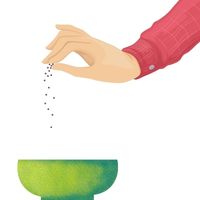
Dig a 12 inch hole in the potting mix. Put the horseradish crown side up in the hole at a 45 degree angle. This angle makes it easy for the roots to grow downward. The tapered side should be in the bottom.
Place the crown in such a way that you can cover it with almost 2 inches of potting soil.
If possible, cover the potting mix with mulch such as pine straw or hay.
Within a week you will start seeing some sprouts growing from the soil.
Once you have already have one successful season, save those small little horseradish roots attached to thee main big root.
You can use these little horseradish “starts” to grow horseradish in container in the next season.
Submerge these small little knobs in jars filled with water. In about 4 weeks you will have 4-5 inch small horseradish plants which are ready to be transplanted in a container.
Another horseradish sowing method can be using root cuttings. Split the root into 4 pieces, each having some parts of leaves and root tissue. Let these parts heal for some days and then sow them in the pot as discussed above.
Quick tip: You can even save horseradish for the next season in refrigerator. Keep the horseradish in a zip lock bag and poke some holes in the bag. The climate in the refrigerator will mimic the climate for dormancy.
Watering
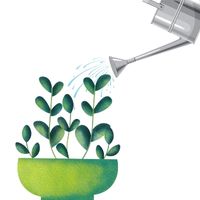
Water the potting mix when you are sowing the horseradish.
Once the plant is established, reduce the frequency of water. May be once every week or two. This also depends on the climate. The whole idea is to not let the soil completely dry.
Do not over water the pot. Waterlogged soil is not good for horseradish plant as it will cause root rot.
Too little water will lead to woody root. On the other hand, too much water will lead to highly pungent soft roots.
Make some drainage holes at the bottom of the container to drain the water just in case excess water is used while watering horseradish.
Refer How to make drainage holes on potting container for more details.
Harvesting

Horseradish takes 120-150 days to completely mature.
Horseradishes planted in spring can be harvested in Fall season (in the moth of October and November).
Horseradish planted in fall can be harvested in late spring (in the months of July and August).
Dig around the plant and lift (not pull) the large, central root and as many of the smaller roots as you can from the base of the plant.
Trim the top leaving 1 inch of it attached to the root.
Scrub the roots and remove the dirt.
Quick tip: In case you want a stronger flavor, harvest the horseradish after few frosts.
Plant care
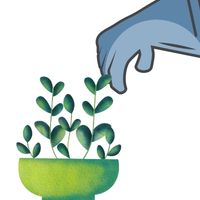
Remove all leaf shoots except the top one after the plant starts growing, in order to produce smooth, strong roots. Dig around the plant again once the leaves reach one foot in height and carefully remove the big lateral roots. By doing this, the main root will grow faster.
By mulching with leaves, pine straw, hay or compost, you will be able maintain moisture and suppress weeds.
In case you plant to use fertilizers, you can add 1 teaspoon of nitrogen (21-0-0) per plant on 4th and 8th week after planting. However, refrain from overdosing as it will lead to excessive root branching and top growth.
Regularly weed the pot.
SUBSTITUTES FOR HORSERADISH IN THE KITCHEN
- Wasabi
- Mustard
- Ginger
How to keep Horseradish fresh
Intact roots can be stored in refrigerator for up to 3 months. Use a plastic zip lock bag. make few holes in the bag for air circulation.
Grated horseradish can be stored in the fridge for about a month.
Roots of horseradish can also be stored in a dark root cellar in moist sand or sawdust.
Small pieces of horseradish roots can be frozen and kept in a freezer for as long as six months.
Please refer to how to store herbs and spices for more details.
How to use Horseradish in the kitchen
Many cold-temperate countries around the world use both the leaves and roots of this plant to prepare traditional dishes.
In many European cultures, horseradish has become a traditional food, and it is often used in Jewish and Eastern European cuisine.
Horseradish is mainly used as a condiment in grated form or as a paste or sauce to enhance the flavor of other foods, particularly meat. However, it can also be consumed raw, pickled, or cooked.
It is common to combine grated or ground roots with cream, mayonnaise, mustard, oil, salt, vinegar, or yogurt.
When compared with horseradish root, leaves have more limited culinary uses, with the most common uses being salads and combining with other herbs or vegetables.
Dishes that go well with Horseradish : Salads, Dips, pickles, soups, marinades, cream, dressing, fermented vegetables.
Preparation of Horseradish for food : Peeling and preparing horseradish will expose you to the intense odor. The intensity increases even more when you grate it. If possible do it in a ventilated place (to save you from sniffles and tears).
You can use a food processor instead of grating it manually.
Peel and cut the horseradish root into chunks after scrubbing it clean.
Mix with lemon juice or vinegar to preserve the flavor.
Pairing Horseradish with food
Seasonings that go well with Horseradish:
Worcestershire sauce, parsley, cayenne, mustard, celery seed, garlic, lemon juice, paprika, fennel, dill.
Fruits and Vegetables that go well with Horseradish :
Potatoes ( White Potato, Red Potato, Russet Potato, Purple Potato ), tomatoes, onions, carrots, beets, celery, broccoli, cabbage (red cabbage, green cabbage), endive (curly endive, belgian endive), parsnips, lettuce ( romaine lettuce, leaf lettuce, iceberg lettuce ), turnips, cauliflower, lemon.
Proteins that go well with Horseradish:
Fish and seafood, Eggs, beef, cheeses, ham, duck, chicken.

